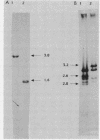Abstract
The cryptic bgl operon in Escherichia coli K-12 strain 1011A contains a 1.4-kilobase-pair fragment of foreign DNA within the bglF structural gene. The active allele found in its descendant strain, MK1, required the precise excision of that insertion for its activation. Molecular and genetic approaches have shown that strain 1011A possessed an active (bglR+) rather than a silent wild-type (bglR0) allele of the regulatory region and that this change was caused by a point mutation. Our model for the retention of cryptic genes (B. G. Hall, S. Yokoyama, and D. H. Calhoun, Mol. Biol. Evol. 1:109-124, 1983) suggested that the insertion might have been selected to silence a disadvantageous bglR+ allele. We examined the genealogy of strain MK1 and found that the insertion of foreign DNA was not selected for that reason, since it preceded the change to bglR+. This means that the change to bglR+ was also not selected, since the presence of the insertion would not allow expression of the operon. We have calculated the probability of isolating a bglR+ mutation by chance alone as less than 10(-8). We suggest that mutation rates estimated under the usual conditions of exponential growth may be irrelevant to the frequencies of these events under natural conditions.
Full text
PDF




Images in this article
Selected References
These references are in PubMed. This may not be the complete list of references from this article.
- Dalrymple B., Caspers P., Arber W. Nucleotide sequence of the prokaryotic mobile genetic element IS30. EMBO J. 1984 Sep;3(9):2145–2149. doi: 10.1002/j.1460-2075.1984.tb02104.x. [DOI] [PMC free article] [PubMed] [Google Scholar]
- Ghosal D., Sommer H., Saedler H. Nucleotide sequence of the transposable DNA-element IS2. Nucleic Acids Res. 1979 Mar;6(3):1111–1122. doi: 10.1093/nar/6.3.1111. [DOI] [PMC free article] [PubMed] [Google Scholar]
- Hall B. G., Betts P. W. Cryptic genes for cellobiose utilization in natural isolates of Escherichia coli. Genetics. 1987 Mar;115(3):431–439. doi: 10.1093/genetics/115.3.431. [DOI] [PMC free article] [PubMed] [Google Scholar]
- Hall B. G., Yokoyama S., Calhoun D. H. Role of cryptic genes in microbial evolution. Mol Biol Evol. 1983 Dec;1(1):109–124. doi: 10.1093/oxfordjournals.molbev.a040300. [DOI] [PubMed] [Google Scholar]
- Hashimoto-Gotoh T., Franklin F. C., Nordheim A., Timmis K. N. Specific-purpose plasmid cloning vectors. I. Low copy number, temperature-sensitive, mobilization-defective pSC101-derived containment vectors. Gene. 1981 Dec;16(1-3):227–235. doi: 10.1016/0378-1119(81)90079-2. [DOI] [PubMed] [Google Scholar]
- Klaer R., Kühn S., Tillmann E., Fritz H. J., Starlinger P. The sequence of IS4. Mol Gen Genet. 1981;181(2):169–175. doi: 10.1007/BF00268423. [DOI] [PubMed] [Google Scholar]
- Kothary R. K., Jones D., Candido E. P. IS186: an Escherichia coli insertion element isolated from a cDNA library. J Bacteriol. 1985 Nov;164(2):957–959. doi: 10.1128/jb.164.2.957-959.1985. [DOI] [PMC free article] [PubMed] [Google Scholar]
- Kricker M., Hall B. G. Directed evolution of cellobiose utilization in Escherichia coli K12. Mol Biol Evol. 1984 Feb;1(2):171–182. doi: 10.1093/oxfordjournals.molbev.a040310. [DOI] [PubMed] [Google Scholar]
- Luria S. E., Delbrück M. Mutations of Bacteria from Virus Sensitivity to Virus Resistance. Genetics. 1943 Nov;28(6):491–511. doi: 10.1093/genetics/28.6.491. [DOI] [PMC free article] [PubMed] [Google Scholar]
- Mahadevan S., Reynolds A. E., Wright A. Positive and negative regulation of the bgl operon in Escherichia coli. J Bacteriol. 1987 Jun;169(6):2570–2578. doi: 10.1128/jb.169.6.2570-2578.1987. [DOI] [PMC free article] [PubMed] [Google Scholar]
- Ohtsubo H., Ohtsubo E. Nucleotide sequence of an insertion element, IS1. Proc Natl Acad Sci U S A. 1978 Feb;75(2):615–619. doi: 10.1073/pnas.75.2.615. [DOI] [PMC free article] [PubMed] [Google Scholar]
- Prasad I., Schaefler S. Regulation of the beta-glucoside system in Escherchia coli K-12. J Bacteriol. 1974 Nov;120(2):638–650. doi: 10.1128/jb.120.2.638-650.1974. [DOI] [PMC free article] [PubMed] [Google Scholar]
- Reynolds A. E., Felton J., Wright A. Insertion of DNA activates the cryptic bgl operon in E. coli K12. Nature. 1981 Oct 22;293(5834):625–629. doi: 10.1038/293625a0. [DOI] [PubMed] [Google Scholar]
- Reynolds A. E., Mahadevan S., LeGrice S. F., Wright A. Enhancement of bacterial gene expression by insertion elements or by mutation in a CAP-cAMP binding site. J Mol Biol. 1986 Sep 5;191(1):85–95. doi: 10.1016/0022-2836(86)90424-9. [DOI] [PubMed] [Google Scholar]
- Schnetz K., Toloczyki C., Rak B. Beta-glucoside (bgl) operon of Escherichia coli K-12: nucleotide sequence, genetic organization, and possible evolutionary relationship to regulatory components of two Bacillus subtilis genes. J Bacteriol. 1987 Jun;169(6):2579–2590. doi: 10.1128/jb.169.6.2579-2590.1987. [DOI] [PMC free article] [PubMed] [Google Scholar]
- Sommer H., Cullum J., Saedler H. Integration of IS3 into IS2 generates a short sequence duplication. Mol Gen Genet. 1979;177(1):85–89. doi: 10.1007/BF00267256. [DOI] [PubMed] [Google Scholar]




